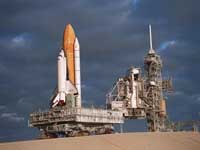Parts of space shuttle powered down in case extra day is needed at space station
Engineers tested whether a bad power feed going into the Russian side of the international space station was causing failures in computers that control the outpost's orientation and produce oxygen.

The feed may be disrupting the sensitive computers built by Daimler-Benz for the European Space Agency, Mike Suffredini, NASA's space station program manager, said Thursday.
The power feed hooks up the Russian side to a pair of new solar arrays that were delivered to the space station by the shuttle Atlantis and connected to the orbiting outpost by two of Atlantis' crew members during a spacewalk Monday.
"A power line has a certain magnetic field around it, and that can affect systems near it," Suffredini said. "This is the leading theory today."
Late Thursday, in an effort to fix the problem, flight controllers planned to disconnect power feeds that go between the U.S. and Russian sections of the space station and then reboot the computers in the morning as the station passes over Russian command centers 220 miles (354 kilometers) below.
If the power feed from the new arrays turns out to be the problem, the Russian section can get power from other solar arrays.
Meanwhile, cameras, computer laptops and some lights on Atlantis were turned off Thursday to save energy in case it needs to stay an extra day at the station to help maintain the outpost's orientation while the problem with the Russian computers is addressed. The mission had already been extended from 11 to 13 days to repair a thermal blanket that peeled during launch.
While Atlantis is still docked, its thrusters can help, if needed, to maintain the station's position. Gyroscopes on the U.S. side of the space station also were helping maintain orientation, but they can't do the job full time.
Bill Gerstenmaier, NASA's associate administrator for space operations, called the chances of abandoning the space station because of the computer problem "remote." Seven visiting shuttle astronauts and three crew members are currently living at the orbiting outpost.
"We're still a long way from where we would have to de-man the space station," Gerstenmaier said.
This type of massive computer failure had never been seen before on the space station, although individual computers do fail periodically.
"These sorts of things happen," said astronaut Ed Lu, who lived at the space station for six months in 2003. "I don't think it's that serious."
A new array was unfolded outside the station Tuesday to help provide power, and astronauts spent Wednesday hooking up a joint that will let the arrays track the sun. Flight controller and astronauts continued Thursday to fold an old solar wing that will be relocated later this year. Fifteen of the wing's 31 sections were folded up by Thursday afternoon.
Astronauts going on the mission's third spacewalk Friday may try to help shake loose some of the stuck wires on the 115-foot (35.05-meter) solar wing.
The spacewalking astronauts also will repair a torn thermal blanket on Atlantis, located over an engine pod near the shuttle's tail.
Engineers don't think the damaged section of the thermal blanket, which protects part of the shuttle from the blazing heat of re-entry, would endanger the spacecraft during landing. But it could cause enough damage to require schedule-busting repairs.
NASA has focused intensely on any problems that could jeopardize a shuttle's re-entry into Earth's atmosphere since shuttle damage resulted in the 2003 Columbia disaster that killed seven astronauts.
Atlantis' scheduled landing next Thursday will not be affected by a strike of shuttle program workers at Kennedy Space Center in Cape Canaveral, Florida. The union representing a contractor's employees has agreed to keep shuttle recovery workers on the job until landing.
Subscribe to Pravda.Ru Telegram channel, Facebook, RSS!


